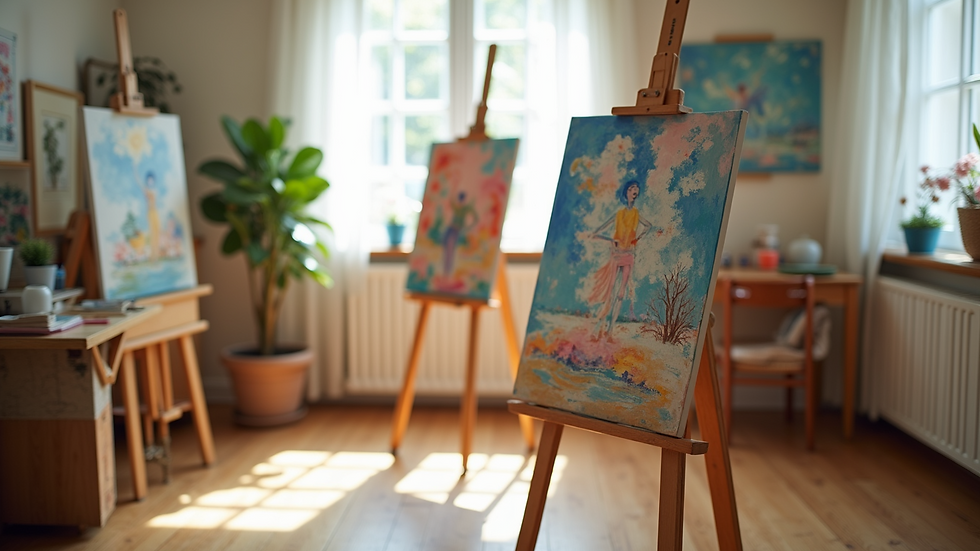Discover the Benefits of Holistic Art Therapy
- Alissa Zemering, MA, ATR,LCAT

- Sep 21
- 4 min read
Art has long been a powerful tool for expression and healing. In recent years, creative art therapy methods have gained recognition for their ability to support mental, emotional, and physical well-being. These approaches combine creativity with therapeutic techniques to help individuals explore their feelings, reduce stress, and foster personal growth. This article explores the many benefits of creative art therapy methods and offers practical insights into how they can be integrated into daily life.
Understanding Creative Art Therapy Methods
Creative art therapy methods involve using various art forms—such as painting, drawing, sculpture, and collage—to facilitate healing and self-discovery. Unlike traditional talk therapy, these methods allow individuals to express thoughts and emotions that may be difficult to verbalize. The process of creating art can unlock subconscious feelings and provide a safe space for exploration.
Some common creative art therapy methods include:
Expressive painting: Using colors and brush strokes to convey emotions.
Clay modeling: Shaping clay to represent inner experiences.
Collage making: Combining images and textures to tell a personal story.
Mandala drawing: Creating circular designs to promote mindfulness and balance.
These techniques are adaptable to all ages and abilities, making them accessible and inclusive.

How Creative Art Therapy Methods Enhance Mental Health
Creative art therapy methods offer numerous mental health benefits. Engaging in artistic activities can reduce anxiety, depression, and stress by providing a distraction from negative thoughts and encouraging relaxation. The act of creating art stimulates the brain’s reward system, releasing dopamine, which improves mood and motivation.
For example, a person struggling with anxiety might use expressive painting to externalize their worries. By putting their fears on canvas, they gain perspective and a sense of control. Similarly, someone dealing with grief can use collage making to piece together memories and emotions, facilitating the healing process.
In addition, creative art therapy methods promote self-awareness. As individuals reflect on their artwork, they often uncover hidden feelings and patterns. This insight can lead to better emotional regulation and healthier coping strategies.
Practical Creative Art Therapy Methods to Try at Home
Incorporating creative art therapy methods into your routine does not require professional training or expensive materials. Here are some simple, practical ideas to get started:
Daily Doodle Journal
Set aside 10 minutes each day to doodle whatever comes to mind. This practice encourages free expression without judgment.
Emotion Wheel Painting
Draw a circle divided into sections, each representing a different emotion. Use colors and shapes to fill each section based on how you feel.
Nature Collage
Collect leaves, flowers, and other natural items. Arrange and glue them onto paper to create a collage that reflects your connection to nature.
Clay Stress Balls
Mold small balls of clay to squeeze when feeling stressed. This tactile activity can be calming and grounding.
Mindful Mandalas
Use templates or freehand draw mandalas. Focus on the repetitive patterns to enhance mindfulness and reduce anxiety.
These activities can be adapted to suit individual preferences and schedules. The key is to approach them with openness and curiosity rather than perfectionism.

The Role of Holistic Art Therapy in Overall Wellness
Integrating creative art therapy methods into a broader wellness plan can amplify their benefits. Holistic art therapy combines artistic expression with mind-body techniques such as meditation, breathwork, and energy healing. This comprehensive approach addresses the whole person—body, mind, and spirit.
For instance, a session might begin with guided meditation to center the individual, followed by an art activity that encourages emotional release. The therapist may then incorporate gentle movement or visualization to deepen relaxation and integration.
This synergy supports healing on multiple levels, helping individuals achieve greater balance and resilience. It also fosters a deeper connection to oneself and the surrounding environment.
Tips for Finding the Right Creative Art Therapy Program
If you are interested in exploring creative art therapy methods with professional guidance, consider the following tips:
Research credentials: Look for licensed art therapists or certified practitioners with relevant experience.
Check program focus: Some programs specialize in trauma, addiction, or specific populations like children or seniors.
Evaluate format: Decide whether you prefer individual sessions, group workshops, or online classes.
Read reviews: Testimonials can provide insight into the effectiveness and atmosphere of the program.
Ask about materials: Confirm if supplies are provided or if you need to bring your own.
Many community centers, wellness clinics, and private practices offer creative art therapy programs. Starting with a trial session can help you determine if the approach resonates with your needs.

Embracing Creativity for Lifelong Healing
Creative art therapy methods are more than just artistic activities—they are powerful tools for healing and self-discovery. By engaging in these practices, individuals can unlock emotions, reduce stress, and cultivate a deeper understanding of themselves. Whether practiced independently or with a professional, creative art therapy offers a path to greater well-being and resilience.
Explore the possibilities of creative expression and consider how these methods might enrich your life. With patience and openness, art can become a trusted companion on your journey toward healing and growth.




Comments